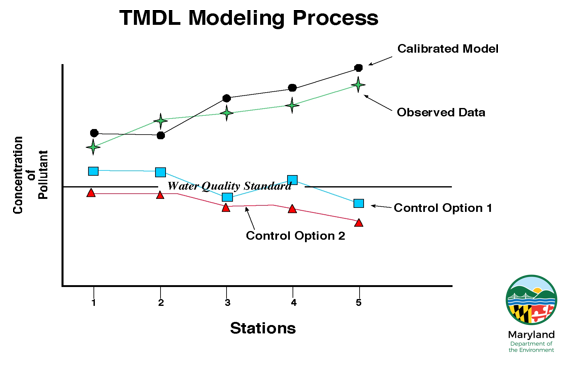Total Maximum Daily Loads (TMDL)
Main_Content
Total Maximum Daily Loads (TMDLs) are a requirement, found in §303(d), of the federal Clean Water Act (CWA) that became law in 1972.
The CWA requires that Maryland:
- Establish Water Quality Standards (WQS) for its waters.
- Monitor the conditions of its waters.
- List waterbodies that do not meet WQSs with technology-based controls alone (303(d) list).
- Set priority rankings for the waterbodies listed.
- Establish TMDLs that meet WQS for each listed waterbody.
- Solicit public comment.
- Submit 303(d) list and TMDLs to EPA for approval.
- Incorporate TMDLs into the State's
Continuing Planning Process.
Waterbodies require TMDLs when the following pollution control requirements are not stringent enough to meet applicable WQSs:
- Technology-based effluent limitations required by the CWA;
- More stringent effluent limitations required by either State or local authority; and
- Other pollution control requirements (e.g., best management practices) required by local, State, or Federal authority are not stringent enough to implement any water quality standard applicable to such waters.
In Category 5 of Maryland's Integrated Report of Surface Water Quality (Integrated Report) is the current list of waterbodies that may require TMDLs. The 2024 Integrated Report was approved by EPA September 4, 2024. For more information about the 2024 Integrated Report, please click here.
The current list identifies 134 impaired watersheds. Various combinations of waterbodies and pollutants result in over 850 potential TMDLs statewide.
A TMDL is the sum of the allowed pollutant loads for point sources, non-point sources, projected growth and a margin of safety.
TMDL = Point Sources + Nonpoint Sources + Projected Growth + Margin of Safety
Load allocations are determined through the review of monitoring data and watershed modeling. The tools used depends upon the complexity of the problem.

- Describe Impairment
- Identify Cause of Impairment
- Set Quantitative Goal or Endpoint
- Identify Pollutant Sources
- Describe Methodology
- Determine Allowable Load and Allocation
- Determine Margin of Safety
- Public Involvement
- Provide Reasonable Assurance of Implementability
- The document called "Maryland's TMDL Development Program and Local Government Participation" was created with the help of stakeholders to provide an outreach policy followed by the Department with local governments.
- Once work on a specific TMDL begins, local governments, identified interested parties, and appropriate dischargers in that watershed will be consulted during key stages of development.
- Introductory TMDL briefings may be provided upon request. A second round of more in-depth briefings will be provided to those who request more detail.
- The public is invited to become involved in the listing process.
- After a draft TMDL has been developed, a formal public notice and comment period will be provided prior to the TMDL's submission to EPA.
- When a TMDL is approved, stakeholders will participate in determining how the TMDL should be implemented to reach allowable loading levels.
- Summary Presentation of the TMDL Development Process (.pdf, 477KB)
- Monitor pollutant loadings.
- Track implementation and effectiveness of controls.
- Assess water quality trends in the waterbody.
- Reevaluate TMDL for attainment of water quality standards.
- Watersheds with TMDL Documents (A-Z)
- Maryland has been developing polychlorinated biphenyl (PCB) TMDLs. For more information about PCBs and Maryland's waters, see our fact sheet about PCBs.
- Maryland has created the TMDL Data Center where you may find TMDL loads, allocations, summary data and GIS files.
- Maryland has identified stressors of biological impairment. For more information about these biological stressor identification reports, click here.
- As a partner with the other Bay watershed jurisdictions and EPA, Maryland played a key role in the development of the Chesapeake Bay TMDL, established by EPA in December 2010. An EPA website dedicated to the Bay TMDL is available as as an important source of information about the nation's largest collective TMDL, which includes nutrient and sediment TMDLs for 58 Maryland Bay water quality segments. The EPA website is regularly updated with new information about the Bay jurisdictions' efforts to implement the nutrient and sediment reductions required to meet the Bay TMDL. Click here to visit this site (you will be leaving MDE's website).
- The Department has also created its own website dedicated to Maryland's Watershed Implementation Plan (WIP) for the Chesapeake Bay TMDL, to disseminate information regarding the State's ongoing planning process and actions to achieve the Maryland-specific pollution reduction goals of the Bay TMDL. Click here to visit this site.
- The 2024 Final Integrated Report of Surface Water Quality [303(d) List] has been approved by EPA and is now available. For more information, click here.
- For a list of additional TMDL-related links, click here.
Center_Content
Contact Information
Please direct questions or comments concerning Maryland's TMDL Program to
[email protected] or call (410) 537-3884.
Last updated:5/2024
